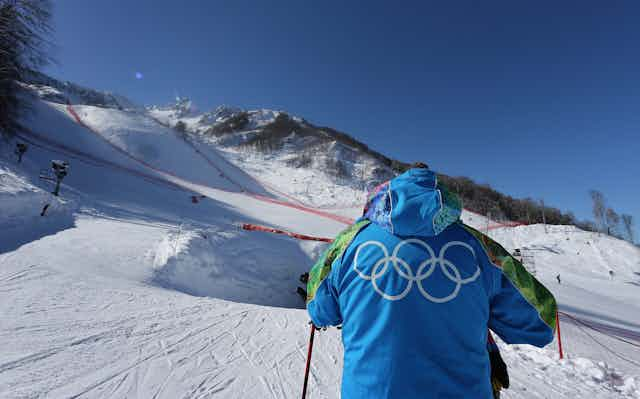Since the late 1990s, the International Olympic Committee (IOC) has been committed to sustainable development. Since the Agenda for the Olympic Movement in the 21st Century (Agenda 21) was adopted in 1999, the environment has become the third pillar of the Olympic movement, along with sport and culture.
The IOC works closely with the United Nations Environment Program (UNEP) to assist the hosts of the Olympic Games (summer and winter) to manage the environmental impacts of the Games.
So can we expect similar standards at the Sochi Winter Olympics?
There are environmental issues associated with all mega events such as the Olympic and Commonwealth Games. These are inevitable given the scale of development needed to host such large events, and the numbers of people attending.
The Winter Olympics take place at a relatively high altitude (often halfway up a mountain) so developing the infrastructure and services needed to host a large event is made more difficult by this terrain.

Such alpine or mountainous areas are often important nature reserves too – but the Sochi Winter Olympics 2014 has promised a wide range of measures to minimise any negative environmental impact and return “a rich green legacy”, according to a newsletter from 2012.
The Sochi 2014 organising committee has developed an environmental strategy based on four key strategic directions:
- a Games in harmony with nature
- a Games with minimal impact on climate
- a zero waste Games
- an enlightenment Games.
According to the the organising committee’s Games Bid, all construction is being completed to green building standards. They are also modernising roads, power plants, and water and waste treatment facilities.
They hope to increase awareness of environmental issues both in Sochi and in Russia more generally. According to the official Sochi 2014 website, 97% of all construction waste has been reused directly at the Olympic sites.
New cleaning and sewerage facilities have been built, and they have implemented a strict policy of waste separation with as much as possible going for recycling.

So far, so good, so green …
It is estimated by the organisers that the Games (including the Olympic and the Paralympic Winter Games) will generate around 250,000 to 360,000 metric tons of CO2 emissions . The organising committee states that this will be mitigated over the next ten years through their Sustainable Future program.
The goal of the Sochi 2014 Organising Committee is to preserve the unique natural environment, including the protected natural assets in the Sochi National Park. They have already implemented a program of “compensatory measures”, which has included relocating around 1,000 wild animals from the Games construction sites.
They have planted more than 160,000 new trees and are releasing 3 million young salmon into neighbouring rivers. The Sochi 2014 Olympic Games Organising Committee even won an award for sustainable development and environmental protection at the International Sport Event Management Awards in 2011.
… but there’s always a but

The Winter Olympics has been on the receiving end of a fair amount of negative publicity regarding its environmental credentials. There are other criticisms too, including the possibility of terrorist attacks, the US$51 billion price tag of the Games and the negative publicity surrounding Russia’s anti-gay laws.
Local environmentalists claim that the Games are nowhere near as environmentally friendly as they were promised to be. They allege illegal dumping of waste has been taking place and that there has been limited access to drinking water for locals during the construction process.
They even claim that the local Mzymta River was straightened to make way for some of the infrastructure being built.
It has been suggested by TIME magazine that the Olympic sites are threatening a unique environment and one of Russia’s most ecologically valuable areas.
Expressing opposition in Russia is politically risky. The truth or otherwise of these claims remains to be proved. What is certain is that such a large-scale development in a hitherto relatively undeveloped area is bound to affect the environment. These long term impacts will mostly stem from the change in land use.
But the destruction of natural habitats and the changes in the appearance of a once unspoilt wilderness are also important impacts too. Changing land use and construction also brings increased risks – of erosion, landslips, mudslides and avalanches – not to mention the increased tourist numbers in a sensitive national park.
Even with all the carbon offsetting, green buildings and zero waste, the city of Sochi and its surrounding national park and wilderness areas will never be the same again. Is this really the “rich green legacy” the organisers have promised?

